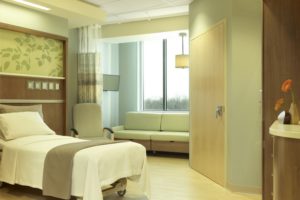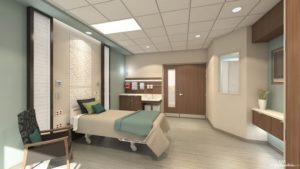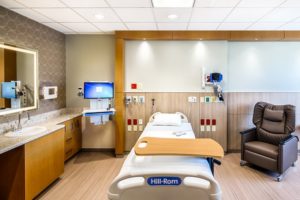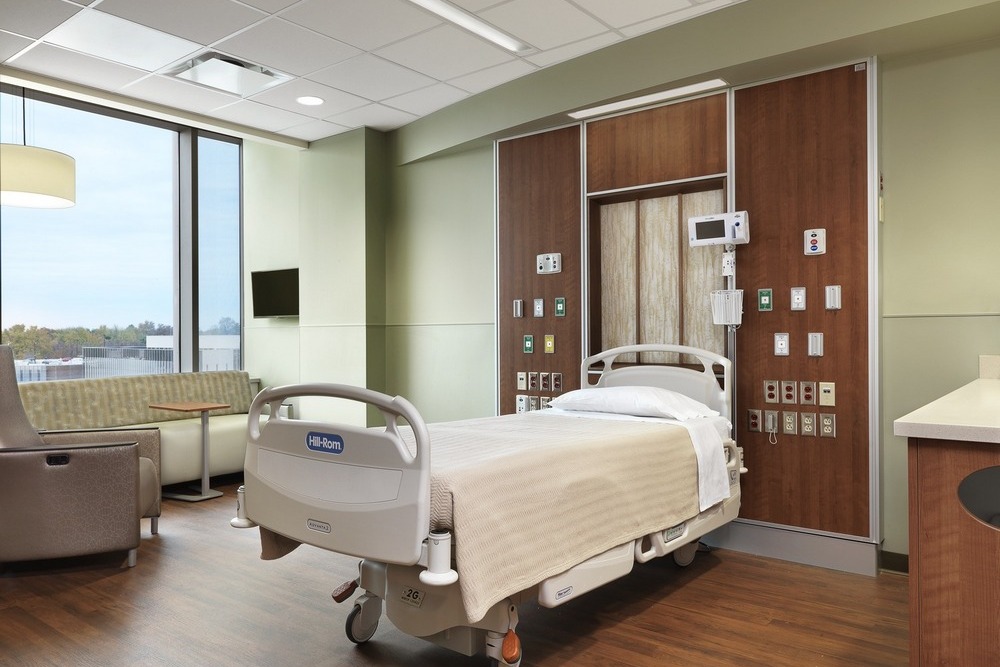In today’s healthcare environment of dwindling reimbursements, increased volumes and higher demand for patient satisfaction, there is a push to optimize space and leverage technology to work as effectively as possible. To make the best use of space and resources, healthcare leaders are looking to right-sized patient smart rooms to optimize efficiency.
These highly designed smaller spaces accommodate the patient and family just as larger rooms would while meeting the Facility Guidelines Institute requirements. Technology enables providers to deliver care more efficiently and creates environments that are interactive and informational for patients.
The result? A patient room that maximizes available space, lowers construction and operational costs, improves process flows for providers and improves patient and family satisfaction. The following are insights into right-sized patient smart rooms:
Creative design maximizes space
The right-sized smart rooms’ concept was developed starting on UPMC East, a 156-bed community hospital (Monroeville, Pennsylvania), and refined through a series of UCHealth community hospitals designs like UCHealth Greeley (Colorado) designed by BSA LifeStructures. The insights gained have led to criteria and a process for planning. The FGI Guidelines recommend the following space for a patient/family centered patient room: 250-square foot minimum and an additional 30 square feet per family member. The design teams met all the required FGI criteria, but they challenged the recommendation of 250 square feet with these innovative rooms and successfully proved that it is possible to optimize smaller spaces through careful design decisions.
Healthcare leaders are conscious of each square foot in a new design as the industry is increasingly permeated by business decisions. With reimbursements changing, hospitals are expected to provide more care for less money. As facilities not only involve first costs, but also lifecycle costs, literally every square foot holds financial impact.

A set of criteria for maximizing space was created and prioritized into guiding principles across multiple projects. The principles deal with such things as patient safety, flexibility and visibility around the patient bed and from the corridor, maximizing natural light, providing a comfortable sitting area for family members, digitizing the nurse charting area and planning the bathroom—size, layout, ADA compliance and bariatric accommodations.
With the space conditions of the right-sized room, the design teams for each project established zoning in the room. Using mock-ups and soliciting provider feedback, the team organized the space in the most user-friendly configuration. Resources for the providers were nearest the door, and the family/caregiver zone was located on the other side of the patient, so that family members could be active participants in the patient’s care, and be near the window. The hand-washing sink was in plain view of the patient and provider, to encourage caregivers to use it as soon as they entered and exited the room.

Natural illumination makes a room feel larger, so daylighting was key in the right-sized rooms. Through a computer simulation process called daylight factor analysis, the team analyzed how far into the room, and the corridor, daylight could penetrate with different lighting scenarios. In addition to optimizing the natural daylight in the room, they had to minimize glare. The team placed windows at varying heights on the wall with blinds to control the level of sunlight in each room. Because natural light shifts throughout the day and throughout the year, they added exterior, horizontal sun shades to the building skin for the summer months and vertical interior solar shades for the winter months—to control the glare. A surprising result of the daylight analysis was a decision to move the patient restroom inboard, opening up natural light on the outside perimeter. This also kept infrastructure piping away from the outside wall where it could freeze, which was an added benefit.
Smaller but smarter
Technology can make the provider’s work more streamlined and the patient’s stay more comfortable by putting patients in control of their own care. They can access information about their diagnosis and their care providers, giving them the security of informed decision-making.
In a smart patient room, information is conveyed through the monitor at the foot of the bed. As soon as a provider enters the room, the display immediately informs the patient of the provider’s name and role, based on the information generated by the patient’s ID tag. The patients can access information about their treatment online using the monitor as an interface. Providing patients access to information they can receive at their own pace makes them feel empowered in a scenario where fast facts delivered by providers can sometimes be overwhelming. The patient can also gain more control with access to a daily schedule informing them of any tests and procedures they have scheduled each day.
Patient satisfaction scores improved as patients and their families were allowed to play a greater role in the care process. The monitor also performs an enhanced version of its original function: entertainment. Patients could access email and digital photos, watch movies and play music. The technology exists to save preferences for lighting, music and entertainment in the room that can be recalled for returning patients, essentially providing a customized-patient experience.

For the providers, the technology saves time. Charting can be choreographed through a touch screen beside the patient’s bed. A workflow alerts caregivers to future tasks and activities and records what tests and procedures have been done previously, and by whom. The monitor provides caregivers access to labs, vital signs and medications throughout the course of the patient’s treatment. The stationary touch screen is also more effective for infection control than a PC with a keyboard that sometimes moves from one room to another.
At the nurses’ station, an outdated dry erase board can be replaced with a smart board listing each room, the patient name and caregiver assigned to it and any special messages about the patient’s treatment, which enhances communication for the entire unit.
Effective strategies for implementation
Mock-ups play a critical role in gathering useful feedback throughout the design process. The project team starts with cardboard mock-ups and then follows an iterative process all the way to final finishes. Each iteration builds on the one before it, including feedback from participants and providing an ongoing frame of reference whenever questions come up. The team used a process they called “structured mock-ups,” which provided participants with a questionnaire about their hands-on experience, rather than soliciting more casual verbal feedback. The hard data they gathered was then analyzed in a structured mock-up review, which became a key piece of the process.
Design details come into focus during the mock-up process. In one scenario, a space was discovered near the sink where dirty food trays could be placed right by the door for easy pick up. In another case, a wardrobe was built into the wall closest to the bathroom, providing access from the family/caregiver zone without blocking the window.
Bathrooms are carefully studied. For example, bathroom layouts create a challenge between the tight space and ADA requirements for accessibility and safety. A sliding door can allow ample room for the patient, provider and any necessary equipment to enter the bathroom. The toilet can be designed closest to the door so patients can access it without crossing the bathroom, and the shower, which is used least often, can be designed into the corner. The bathroom itself was carefully positioned relative to the bed, so patients can reach it as safely and easily as possible.
In such an efficiently designed space, building consensus by working through the details of the entire layout adds value. With such a granular focus, precise design and great attention to detail can mean the difference between being within code requirements or not.
Improved patient outcomes
Patients using the right-sized smart rooms report a higher satisfaction rate thanks to increased communication and control. Safety is improved when automated data reduces human error in patient care, and providers can spend more time with the patient and less time charting, repeating steps and searching for information. A care provider has bedside access to labs and tests that provide a critical picture of the patient’s treatment plan.
Safety is the top priority, followed by patient satisfaction. Making care better, more efficient and, ultimately, less expensive is the trifecta from the perspective of a healthcare leader. A right-sized, smart patient room is the frontier of healthcare design to improve performance in each of these areas.
Photos courtesy of BSA LifeStructures.




